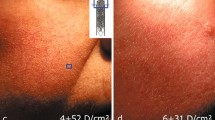Abstract Long-term exposure to silica (SiO2) may induce silicosis as well as extrapulmonary diseases such as scleroderma. Infiltration of mononuclear cells and release of proinflammatory cytokines from these cells have been suggested to play a role in the development of inflammatory and immunological events typical of scleroderma as well as of silica-induced scleroderma. We showed that silica is able to directly activate cytokine expression in blood monocytes, collagenase expression in cultured dermal fibroblasts and ICAM-1 expression in human dermal microvascular endothelial cells. In the study reported here we found that silica and TNF· induce mRNA and protein of the chemokines RANTES and MCP-1 in endothelial cells. In addition, we demonstrated that culture supernatants of silica-treated endothelial cells are chemotactic for mononuclear cells from peripheral blood, suggesting that activation of endothelial cells may contribute to the chemotactic gradient necessary for extravasation of inflammatory blood cells into the surrounding tissue found in early scleroderma. However, a polyclonal anti-RANTES antibody failed to block chemotaxis suggesting that other proteins are involved in this phenomenon. We also studied the expression of RANTES in situ in the skin of systemic sclerosis patients and of healthy individuals. We found abundant RANTES mRNA expression in the skin of SSc patients, whereas in control skin no expression was found. From our data we conclude that RANTES and MCP-1 induction by silica may be an initiating event in inflammatory infiltration, whereas TNF·-mediated inflammation may propagate the disease more efficiently.
Similar content being viewed by others
Author information
Authors and Affiliations
Additional information
Received: 4 August 1999 / Revised: 17 January 2000 / Accepted: 11 February 2000
Rights and permissions
About this article
Cite this article
Anderegg, U., Saalbach, A. & Haustein, UF. Chemokine release from activated human dermal microvascular endothelial cells – implications for the pathophysiology of scleroderma?. Arch Dermatol Res 292, 341–347 (2000). https://doi.org/10.1007/s004030000134
Issue Date:
DOI: https://doi.org/10.1007/s004030000134




